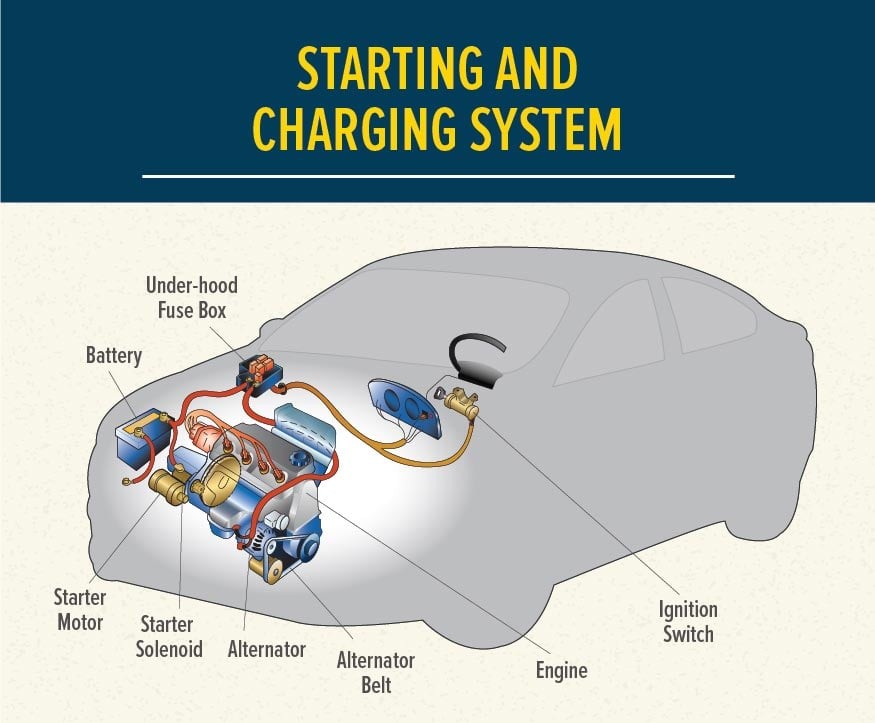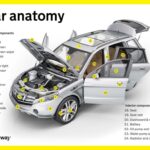Your car battery is essential for getting your vehicle started and powering its electrical components. But have you ever wondered how this battery stays charged while you drive? The answer lies within a crucial part of your car’s engine: the alternator. Let’s dive into understanding What Part Charges The Car Battery and how this system works to keep you on the road.
The primary role of your car battery is to provide the initial burst of energy needed to start your engine. Beyond starting, it also acts as a stabilizer for your car’s computer system and can supply limited power to accessories like lights and the radio when the engine is off. This starting process involves a few key components working in harmony:
- The ignition switch, activated by your key or a start button.
- The starter relay (or solenoid), triggered by the ignition switch, which then closes electrical contacts.
- The starter motor, powered by the battery when the relay closes, engaging gears to crank the engine to life.
 Vehicle Starting and Charging System
Vehicle Starting and Charging System
The Alternator: Your Car Battery’s Charger
The component responsible for charging your car battery while the engine is running is the alternator. Think of the alternator as a mini power plant for your vehicle. It’s driven by a belt connected to the engine, often called the serpentine belt or alternator belt. As the engine runs and turns this belt, the alternator generates electricity.
This generated electricity serves two main purposes:
- Powering Electrical Systems: The alternator supplies power to all of your car’s electrical systems while it’s running, including headlights, windshield wipers, radio, air conditioning, and more.
- Recharging the Battery: Crucially, the alternator also sends a portion of the generated electricity back to the car battery to replenish the energy used during starting and to maintain its charge.
To ensure the battery receives the correct amount of charge and to protect it from damage, a voltage regulator works in conjunction with the alternator. This regulator controls the flow of electricity, preventing overcharging and ensuring a consistent charge level, even when the electrical demands of your car vary, such as when you turn on the air conditioning or heater.
How Car Batteries Provide Power Initially
Car batteries, whether they are flooded or Absorbed Glass Mat (AGM) types, operate using lead-acid technology. Inside a typical lead-acid battery, you’ll find lead plates interlayered with plates of other materials, all submerged in an electrolyte solution. This solution is a mixture of sulfuric acid and water.
When you turn the ignition and initiate the starting process, a chemical reaction begins. The acid in the electrolyte interacts with the active material on the battery plates. “Active material” refers to any substance within the battery that participates in the electrochemical reactions that discharge and recharge the battery. This chemical reaction generates an electrical current, which is then channeled through the starting system to start your engine.
Understanding Cold Cranking Amps (CCA) is also important when discussing car batteries. CCA is a rating that indicates a battery’s ability to deliver power at low temperatures (0°F or -18°C). A higher CCA rating is beneficial, especially in colder climates, as it signifies the battery’s capability to start an engine in cold weather when batteries are less efficient.
Types of Car Batteries: Wet Cell and AGM
While the alternator is responsible for charging, understanding the different types of car batteries can help you choose the right one for your vehicle. The two main types are:
-
Standard Wet Cell Batteries: Also known as flooded or conventional batteries, these require occasional maintenance like checking fluid levels (if they have removable caps) and cleaning terminals.
-
Absorbed Glass Mat (AGM) Batteries: These are sealed, maintenance-free batteries, often found in newer vehicles, especially those with start-stop technology or high electrical demands. AGM batteries are more resilient to deep discharges and can last longer, but they are also more sensitive to overcharging.
It’s crucial to note that wet cell and AGM batteries are not interchangeable. Your vehicle is designed to use one type or the other, so always replace your battery with the type specified for your car.
Battery Lifespan and Common Issues
Car batteries have a limited lifespan due to the wear and tear from repeated discharge and recharge cycles. Over time, the internal components degrade, and the battery’s capacity diminishes, leading to reduced cold cranking amps.
One significant factor contributing to battery failure is deep discharging. This occurs when you excessively use the battery’s power while the engine is off, for example, by leaving the lights or stereo on for extended periods. Deep discharging can cause irreversible damage to the battery plates, shortening its lifespan.
In conclusion, the alternator is the part that charges your car battery, working in tandem with the voltage regulator to ensure your battery remains charged while you drive. Understanding this system and the basics of car batteries can help you maintain your vehicle and address potential battery issues proactively.
Learn More
